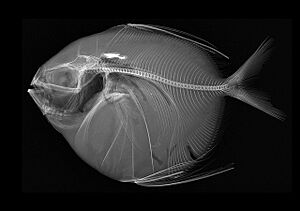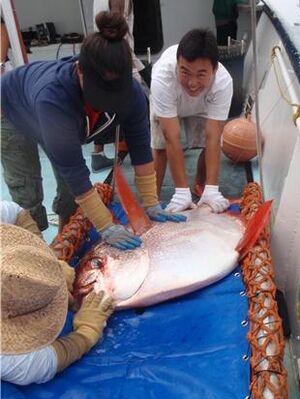Lampris guttatus facts for kids
Quick facts for kids Lampris guttatus |
|
|---|---|
 |
|
 |
|
| Lampris guttatus, conventional and X-ray images | |
| Conservation status | |
| Scientific classification |
The opah, also known as the moonfish or kingfish, is a large, colorful fish that lives in the deep ocean. Its scientific name is Lampris guttatus. This amazing fish belongs to a family called Lampridae.
Opahs live all over the world in the open ocean. They are quite common in places like Hawaii and West Africa. However, they are not often seen in other areas, such as the Mediterranean Sea. Even though they are not usually fished on purpose, they are often caught by accident. This happens when fishing boats are trying to catch other fish, like tuna. In Hawaii, opahs are a popular food in restaurants. Scientists are still learning a lot about where opahs live and how they interact with other sea creatures.
Contents
What's in a Name?
A Danish scientist named Morten Thrane Brünnich first described the opah in 1788. The name Lampris comes from an ancient Greek word, lampros. This word means "brilliant" or "clear." The second part of its name, guttatus, is Latin for "spotted." This refers to the white spots that cover the opah's body.
Scientists used to think there were only two types of opahs. But in 2018, new research showed that the L. guttatus group is actually made of five different kinds of opahs! These different types live in various parts of the world. They also have small differences in their genes and how they look.
Opah's Cool Look
The opah is a big, round, and colorful fish. It can grow up to 2 meters (about 6.5 feet) long. The heaviest opah ever found weighed about 270 kilograms (nearly 600 pounds)!
Its body is a beautiful deep blue color on top, fading to a rosy pink on its belly. White spots are scattered in rows along its sides. All of its fins are a bright, fiery red. Even its mouth is red! The opah's large eyes are ringed with a striking golden yellow color. Its body is covered in tiny, shiny scales.
Opahs have long, curved pectoral fins that stick out from their sides. Their tail fins are wide and shaped like a crescent moon. The fins on their belly are similar to their pectoral fins, but a bit longer. The front part of their top fin is also very long and curved. Their bottom fin is about the same height as the shorter part of their top fin. Both of these fins can fold down into grooves on their body. The opah has a pointy snout and a small mouth with no teeth.
Warm-Blooded Fish?
Most fish are "cold-blooded." This means their body temperature is the same as the water around them. But in 2015, scientists discovered something amazing about the opah. It's the first fish known to be "warm-blooded" all over its body! This means it can keep its body much warmer than the cold ocean water.
How does it do this? The opah constantly moves its large pectoral fins. This movement creates heat. The muscles that move these fins are covered by a thick layer of fat. This fat acts like insulation, keeping the heat inside the fish.
The opah also has a special network of blood vessels in its gills. It's called a rete mirabile (say "REE-tee mee-RAH-bee-lay"). This system works like a heat exchanger. It warms the cold blood coming from the gills before it goes to the rest of the body. This helps the opah keep its whole body, including its heart, about 5°C (9°F) warmer than the surrounding water.
Being warm-blooded helps the opah in many ways. It can swim faster and hunt more effectively in the cold, deep ocean. Most predators in the deep sea are sluggish because of the cold. But the opah's warmth gives it an advantage. It can actively chase its prey, just like tuna and some sharks do.
Where Opahs Live
Opahs are found in oceans all over the world. You can find them in the Atlantic Ocean, from Canada down to Argentina. They also live in the Eastern Atlantic, from Norway to Angola, and in the Mediterranean Sea. In the Pacific Ocean, they are found from Alaska down to California. They also live in the warmer parts of the Indian Ocean. Sometimes, they even venture into the cold Southern Ocean.
These fish spend their entire lives in the open ocean. They usually live at depths between 50 and 500 meters (about 160 to 1,600 feet). Sometimes, they might even go deeper. They prefer water temperatures between 8 and 22°C (46 to 72°F).
Scientists have tagged opahs to track their movements. They found that opahs tend to stay at shallower depths (50-100 meters) during the night. During the day, they dive deeper, usually between 100 and 400 meters. This pattern helps them find food and avoid predators.
Opah Behavior and Life Cycle
Scientists are still learning about the opah's life. They seem to be solitary fish, meaning they usually swim alone. However, they have been seen swimming with schools of tuna.
Opahs swim by moving their large pectoral fins. This helps them glide through the water. They are not super fast swimmers all the time, but they can burst to speeds of up to 4 meters per second (about 13 feet per second) when needed!
Like many other large ocean predators, opahs move up and down in the water column. Their diet mainly consists of squid and krill. They also eat smaller fish.
Opahs likely lay their eggs in the spring. When they first hatch, opah babies are very tiny and slender. They don't have their dorsal or pelvic fins yet. But they quickly change their shape, growing into the round, deep-bodied form of an adult opah.



